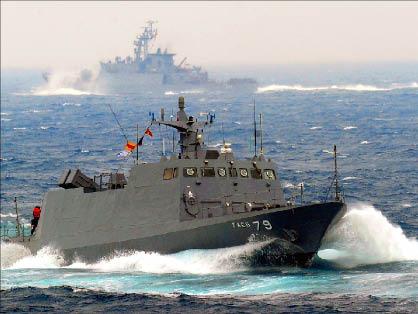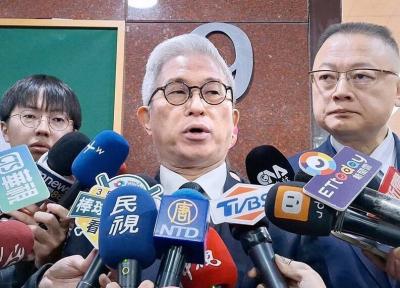The Ministry of National Defense yesterday refused to comment on a report in the Chinese Communist Party-run Guangming Daily saying that the Kuang Hua VI (KH-6) fast attack missile boats that have been in service in the Taiwanese navy since 2010 were plagued by deficiencies and were a “fantasy.”
Taiwan commissioned its first squadron of 11 KH-6 radar-evading fast-attack craft, produced by China Shipbuilding Corp, in May 2010. Since then, 20 more of the 170-tonne boats have entered service, the most recent 10 on Dec. 2 last year at Tsuoying Naval Base in Greater Kaohsiung.
The 31 boats comprise the navy’s three squadrons, which have been dubbed Hai Chiao (Sea Sharks).

Photo: Chang Chung-i, Taipei Times
Each boat, which costs about US$12.3 million, comes equipped with four Hsiung Feng II anti-ship missiles with a range of 150km, as well as a 20mm anti-aircraft gun, a 7.62mm machine gun and decoy systems.
The KH-6s, which have gradually been replacing the Navy’s Israeli-made Hai Ou (Sea Gull)-class missile patrol boats, are integral to the defense of Taiwan’s waters. Given the narrowness of the Taiwan Strait, the boats would be able to attack targets at naval bases along China’s coast.
Some naval experts, including James Holmes of the US Naval War College, have hailed the capabilities of fast-attack craft as a potentially efficient asymmetrical counter to the growing Chinese military.
The Hsiung Feng III, currently under development by the Chung Shan Institute of Science and Technology, is also a main component of Taiwan’s emerging sea defenses.
However, the Guangming Daily on Tuesday claimed that the program was beset with problems and called the Sea Sharks a “fantasy.” At issue, the paper said, was the fact that the guns on the KH-6 needed to be operated manually, which undermined the craft’s “stealth” capability.
The article also said the craft was ill-suited for the rough weather conditions in the Taiwan Strait, pointing to an incident involving a prototype that lost power and became stranded on an outer seawall during Typhoon Jangmi in September 2008.
In all, the paper said, those deficiencies imposed “several restrictions” on the boats’ use.
Contacted by the Taipei Times yesterday, Ministry of National Defense spokesperson Colonel David Lo (羅紹和) said the ministry would not comment on Chinese media reports on Taiwan’s weapons systems.
Asked for comment, Holmes said the navy probably had corrected any deficiencies that lend themselves to easy fixes, such as clutter on the main deck.
“The point about handling well in heavy weather or at sea, however, is not something so easily corrected,” he said via e-mail. “The vessel is top-heavy because of its tall superstructure, which raises its ‘center of buoyancy’ and makes it bob around like a cork in high seas. That compromises its ability to go to sea and fight in all weather.”
“Improving the KH-6’s seakeeping ability would require a major redesign to lower weight within the vessel. That’s not something so easily solved,” Holmes said.
“Calling the craft a ‘fantasy’ overstates things in my view, so our Chinese friends could be indulging in some triumphalism. But I certainly see the KH-6 as only a transitional platform until something better is in the water,” he added.
Wendell Minnick, the Taipei-based Asia bureau chief for Defense News, said the deficiencies mentioned in the article were old ones and that he suspected the navy had ironed most of them out by now.
“The KH-6 missile patrol boat program has experienced developmental problems. One main problem is balancing the weight of larger missiles across the frame,” Minnick told the Taipei Times yesterday. “This has caused some problems in the past, but they appear to be seaworthy at present.”
“For the most part, Taiwan does produce, at the end of the day, impressive weapon systems and in many ways the Taiwanese are some of the best weapons producers in the world,” he said.

A strong continental cold air mass is to bring pollutants to Taiwan from tomorrow, the Ministry of Environment said today, as it issued an “orange” air quality alert for most of the country. All of Taiwan except for Hualien and Taitung counties is to be under an “orange” air quality alert tomorrow, indicating air quality that is unhealthy for sensitive groups. In China, areas from Shandong to Shanghai have been enveloped in haze since Saturday, the ministry said in a news release. Yesterday, hourly concentrations of PM2.5 in these areas ranged from 65 to 160 micrograms per cubic meter (mg/m³), and pollutants were

Taiwan’s armed forces have established response protocols for a wide range of sudden contingencies, including the “Wan Chun Plan” to protect the head of state, the Ministry of Defense (MND) said today. After US President Donald Trump on Saturday launched a series of airstrikes in Venezuela and kidnapped Venezuelan President Nicolas Maduro, concerns have been raised as to whether China would launch a similar “decapitation strike” on Taiwan. The armed forces regularly coordinate with relevant agencies and practice drills to ensure preparedness for a wide range of scenarios, Vice Minister of National Defense Hsu Szu-chien (徐斯儉) told reporters before a

EVA Airways on Saturday said that it had suspended a pilot and opened an investigation after he allegedly lost his temper and punched the first officer several times as their plane was taxiing before takeoff at Los Angeles International Airport. According to a report published on Thursday by The Reporter, the incident occurred after the flight’s Malaysian first officer tried to warn the Taiwanese pilot, surnamed Wen (文), that he was taxiing faster than the speed limit of 30 knots (55.6kph). After alerting the pilot several times without response, the first officer manually applied the brakes in accordance with standard operating

Japanese Councilor Hei Seki (石平) on Wednesday said that he plans to visit Taiwan, saying that would “prove that Taiwan is an independent country and does not belong to China.” Seki, a member of the Japan Innovation Party, was born in Chengdu in China’s Sichuan Province and became a naturalized Japanese in 2007. He was elected to the House of Concilors last year. His views on the Chinese Communist Party (CCP) — espoused in a series of books on politics and history — prompted Beijing to sanction him, including barring Seki from traveling to China. Seki wrote on X that he intends